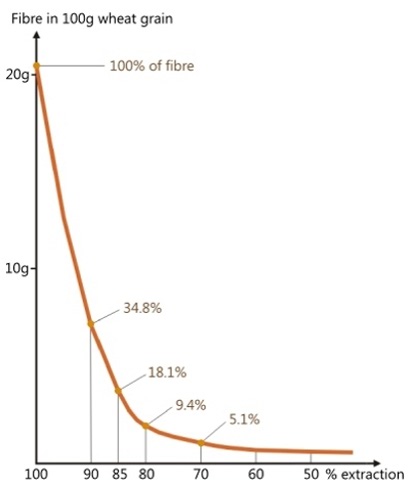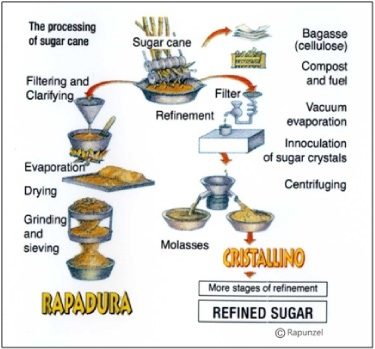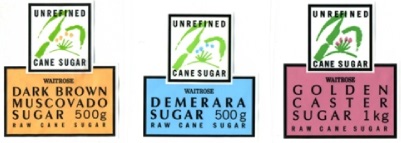

Is Refined Food Really Organic?
By Brane Žilavec, May 2012

The question I am focusing on in this chapter is: What are the results of refining carbohydrate foods on the quality of food produced by this method? For that reason we will look at examples of refined wheat flour and refined sugar, which are quite common examples of Organic Refined Foods (see Glossary of the Key Words).
The refining process belongs to those food processing methods which aim to extract a particular substance out of the whole(food). We need to be aware that only animals eat wholefood in the most essential meaning of this word. People have developed many methods of extraction of food substances out of crops: oil from olives, juice from the apples or sugar cane, brown or white flour from the whole grain, etc. With each specific product we need to decide when we can still talk about wholefood. For this reason we need to look also at the other extreme, when the extraction goes so far that we get a single food substance in its mineral form, as it is the case with sucrose, fructose, and similar substances. In other words, we need to ask: How much extraction/refinement is still natural enough that it is in accordance with the quality of food that the organic movement is striving for.
3.1 Wholemeal versus Refined Flour
The first thing that is lost through refining of wheat flour is fibre. Here is a graph showing the relationship of extraction rate to the amount of fibre in the wheat grain. [1]

The graph shows that on average 100 g of wheat grain contain about 20.5 g of fibre. Now if we take this amount as 100 percent and compare with the extraction rate (i.e. how much of the grain we retain from the whole), we see the following:
A similar pattern of loss can be found in regard to essential minerals and vitamins. In the table below are shown losses of the most important micronutrients in the case of white flour. [3]
| micronutrient | Whole Wheat Grain (per 100g) |
White Wheat Flour (per 100g) |
Percentage Lost |
| Calcium | 44 mg | 15 mg | 66% |
| Iron | 3.3 mg | 1.9 mg | 42% |
| Magnesium | 147 mg | 20 mg | 86% |
| Potassium | 502 mg | 108 mg | 78% |
| Vitamin E | 1400 mg | 400 mg | 71% |
| Vitamin B1 | 480 mg | 60 mg | 87% |
| Folic Acid | 49 mg | 10 mg | 80% |
Fibre, minerals and vitamins are concentrated in the outer layers and germ. When we use wholemeal wheat flour, we use 100 percent of the grain. When we use white flour we still get 80 to 70 percent of the whole grain. But the loss of fibre is about 91 to 95 percent. And we lose also a much higher percentage of minerals and vitamins, mainly between 65 to 85 percent.
3.2 Whole versus Refined Sugar

The above picture [4] compares the production of whole cane sugar with refined cane sugar. For better understanding, we need to look also at the whole sequence of processes involved in the production of white sugar (just for clarification ‘granulated sugar’ is another way to say ‘white sugar’): [5]
See diagram From Cane Sugar to Granulated Sugar
For an illustration here is a description of the one phase of sugar refining, the first after the arrival of sugar into the refinery (beginning of second and third row): "Raw sugar is made up of sugar crystals that have a thin film of impurities on the surface. It is mixed with hot (60 °C) impure syrup (made from a solution of water and sugar) which softens the film. This mixture, known as magma, is a dark brown viscous mass. Magma is fed sequentially into a battery of 14 centrifuges, each of which can spin at up to 1050 rpm with a batch cycle time of about two minutes. This centrifugal force separates the raw crystals from the impure raw syrup." [6]
Rapadura – as an example of whole sugar – has the following composition (approximate values for 100 g of sugar): [7]
| Saccharose [8] | 95 % |
| Potassium | 1300 mg |
| Calcium | 180 mg |
| Magnesium | 70 mg |
| Phosphorus | 37 mg |
| Iron | 8.2 mg |
| Sodium | 1.1 mg |
White sugar is 99.9 or 100% saccharose.
If we now compare the two methods of sugar production we see on one side a simple processing method with a high quality outcome: whole sugar. And on the other side we see more costly and complex processing with the outcome of nutritionally inferior white sugar. In between these two sugars are ‘all shades of brown’: medium brown, light brown, golden brown, light yellow, golden, light tan, beige, light beige, and whitish. [9]
3.3 ‘Natural-Raw-Unrefined’ Sugar
First we will look at an example of sugar marketing inside the mainstream food market. This will help to understand the origin of some practices used also among organic producers (presented in chapter 6: Labelling of Organic Refined Foods).
In the supermarket chain Waitrose the customer can see the following range of various types of cane sugar under the double trade mark ‘Unrefined Cane Sugar’ and ‘Raw Cane Sugar’. In the photo are three labels from this range.

In the table below is the whole range with the basic nutritional information.
| Type of Sugar | Sucrose | Molasses |
| Dark Brown Muscovado Sugar | 90% | 10% |
| Dark Brown Soft Sugar | 94% | 6% |
| Light Brown Muscovado Sugar | 96% | 4% |
| Light Brown Soft Sugar | 98% | 2% |
| Demerara Sugar | 99% | 1% |
| Golden Granulated Sugar | 99.6% | 0.4% |
| Golden Caster Sugar | 99.6% | 0.4% |
Now we will compare this with the above pictures of sugar production. The production of whole and refined sugar has something in common: the first stage of extracting the juice from the sugar cane and evaporation of water; then follow several phases of refining to get pure sugar crystals. For that reason we can distinguish three main groups of sugar [10]:
| Whole Sugar | Partially Refined Sugar | Completely Refined Sugar |
| Sugar which has not been subjected to any refining, and therefore contains all molasses. | Sugar which has gone through one or few refining stages, but still contains some traces of molasses. | Sugar which has been completely refined to pure white sugar crystals. |
From this description it is evident that sugar which has gone through even one single stage of refining cannot be called 'unrefined'. The correct naming would be 'partially refined'. With labelling of all sugars – except the pure white one – as 'unrefined' is simply stretching the meaning of the word over its proper place. In fact it is ludicrous to call something 'unrefined' in spite of fact that it has been refined, but not completely refined. It is more logical to call 'unrefined' such sugar which has not been subjected to any refining.
The expression Raw Sugar is also very deceiving. ‘Raw material’ is usually referring to ingredients in their raw, unprocessed state. But inside the sugar industry it is also common to use the word ‘raw sugar’ for cane sugar which has been already partially processed in the sugar mills, including first separation of molasses by use of centrifuges. This ‘raw’ sugar is then transported to sugar refineries (as you can see on the picture showing the production of granulated sugar). But then one would expect that after sugar enters the refinery and is subjected to the further refining processes it cannot any longer be called ‘raw sugar’. If you look carefully at the above picture, you can notice that after the second use of the centrifuges in the whole sugar production process (or the first centrifuges in the sugar refinery itself) the expression ‘Raw Sugar’ is still used. Only after the last use of the centrifuges appears the expression granulated sugar (i.e., white sugar).
So it looks as if sugar somehow manages to stay in its raw, unprocessed state till the last moment before it turns into pure white sugar crystals. I just wonder when white sugar will be rebranded into raw sugar, for it is used as a raw material in the factories producing sweets, chocolate and similar things.
Now we will look at the word ‘natural’ in relation to sugar. On the website of The Sugar Association one can read (italics mine): "For many people, the term ‘refined’ has lost its original meaning ‘to purify’ and now carries a negative connotation. With sugar the refining process simply removes all impurities and the surrounding plant matter leaving only the pure sucrose… Sugar (sucrose) is a natural carbohydrate, found in fruits and vegetables… Make an informed choice. Choose pure natural sugar – 15 calories per teaspoon." [11]
Here we have an attempt to present white sugar as the natural product because it is extracted from plants and because "cane sugar is neither chemically altered nor bleached to achieve its naturally white color." [12]
We can compare the above approach to the following description, found on the label of an organic sweetener: "Blackstrap Molasses is a natural sweetener with a rich, bitter-sweet taste. This product is refined at source from freshly harvested organically grown sugar cane. After removal of the (white) crystal sugar, all the natural ingredients of the sugar cane are concentrated into the Molasses. Molasses is widely appreciated as a good source of minerals and vitamins." [13]
So both producers are claiming that its product is natural. Both products are described as refined from sugar cane. But the outcomes are so different: the first product is white crystals; the second product is almost black, very thick fluid. It is evident that we cannot solve this issue by looking only at how the food is processed (e.g. alcohol and opium are also natural products, but this does not yet make them safe for human consumption). For that reason we need to look at how the consumption of them affects the human being. [14]
Here is another example of the questionable claim that sugar is ‘100% Natural’: [15]

The producer's description of sugar used in their energy drink is: "Organic Raw FairTrade Sugar is a 100% natural ingredient of Scheckter's Organic Energy Drink." As we have already seen Raw does not mean whole – that is, 100% natural.
From the above examples it is evident that inside the organic movement we need another way of naming and declaring various types of sugars. The other option is to continue with uncritical acceptance and imitation of the above practices which prevents people understanding the true characteristics of sugar processing.
3.4 Quality of Organic Refined Foods
From all my personal experience and knowledge of what constitutes food quality I have no doubt that organic food is in principle better quality than non-organic – though in practice this is not always the case. I always tell people that the quality of any food may vary because of the multitude of factors involved in food production. Any process or substance involved in food production contributes to the final outcome. Nevertheless Organic Refined Foods are in principle better than non-organic ones. But what if we compare the quality of Organic Refined Foods with the quality of the rest of organic food?
In the article by James Cleeton, one can read (italics mine): "The Soil Association conducted a systematic review of the evidence comparing the vitamin and mineral content of organic and conventionally grown food. It was found that, on average, organic food contains higher levels of vitamin C and essential minerals such as calcium, magnesium, iron and chromium. An independent review of the evidence, found that organic crops had significantly higher levels of all 21 nutrients analysed compared with conventional produce; including vitamin C (27% more), magnesium (29% more), iron (21% more) and phosphorous (14% more). Organic spinach, lettuce, cabbage and potatoes showed particularly high levels of minerals." [16]
The first thing that presents a problem is the use of ‘organic food’ and ‘organic crops’ as synonyms. In reality there is an important difference: ‘organic crops’ are not subjected to any food processing, while ‘organic foods’ can be subjected to food processing, including refining. Therefore it is incorrect to claim that "organic food contains higher levels of vitamin C and essential minerals such as calcium, magnesium, iron and chromium", for this cannot hold true for Organic Refined Foods as we saw in the first two topics of this chapter (3.1 Wholemeal vs Refined Flour and 3.2 Whole vs Refined Sugar).
Now, let us make one comparison. We can assume that also organically grown grain crops should in principle have higher levels of trace minerals than non-organic grain crops. In the above article there are no specific numbers for grains, so I will take the above percentages which are referring to all organic crops and compare them with the loss of minerals through the refining of wheat flour (presented in this chapter in 3.1 Wholemeal vs Refined Flour). Although this comparison does not meet strict scientific criteria, it does illustrate the nature of the problem.
| +21% | Iron | -42% |
| +29% | Magnesium | -86% |
| +26% | Calcium | -66% |
| +9% | Potassium | -78% |
Left Column: Increase of particular minerals found in organic food compared to non-organic
Right Column: Loss of particular minerals in white wheat flour compared to the whole wheat kernel
This table shows that losses of minerals due to refining are in principle higher than increases due to organic farming. This is especially true in the case of refined sugars where the losses of minerals and vitamins go up to 100%. This means that Organic Refined Food cannot be promoted as advantageous in regard to the vitamin and mineral content, unless we can provide scientific evidence demonstrating such an advantage. To my knowledge such evidence does not exist.
For me the big question is, is Organic Refined Food any better than Non-Organic Wholefood, not in the environmental sense, but in regard to the effect on human beings? First I need to say that not all non-organic food is in the same quality group; there can be variations depending on the quantities and number of artificial substances used in food production. Lets say that we compare Organic Refined Foods with conventionally produced Wholefoods (for clear distinction between two types see ORGANIC vs CONVENTIONAL FOOD). In my opinion both are bad quality food, but for the different reasons.
Conventional Wholefoods are bad because of low vitality and the remnants of artificial substances used in farming and food processing. They both weaken the human organism, especially its immune system which has to constantly battle against foreign substances in the food.
Organic Refined Foods are bad because of the lack of the fibre, essential minerals and vitamins which are necessary for proper functions of the human organism. In my opinion Organic Refined Foods are simply compromised too much in regard to their intrinsic quality to be capable of nourishing and sustaining me properly in the long term.
CONCLUSION
The main result of refining carbohydrates is denatured, low quality food, stripped of fibre, minerals, vitamins, and other vital nutrients. (Organic) Refined Foods are also inferior in regard to taste, smell, and colour (in spite of the fact that many people today really enjoy such foods). This is due to the lack of phytochemicals which are the source of complex tastes, aromas, and colours of the plants.
On the other side we preserve the intrinsic quality of Organic Wholefood which is due to organic agricultural practices as much as possible. Indeed one can only wonder why one would make such an effort to increase the quality of living soil and consequently the quality of crops, and then, in the case of Organic Refined Foods, all these advantages are literally thrown away through costly and unnecessary refining.

NOTES